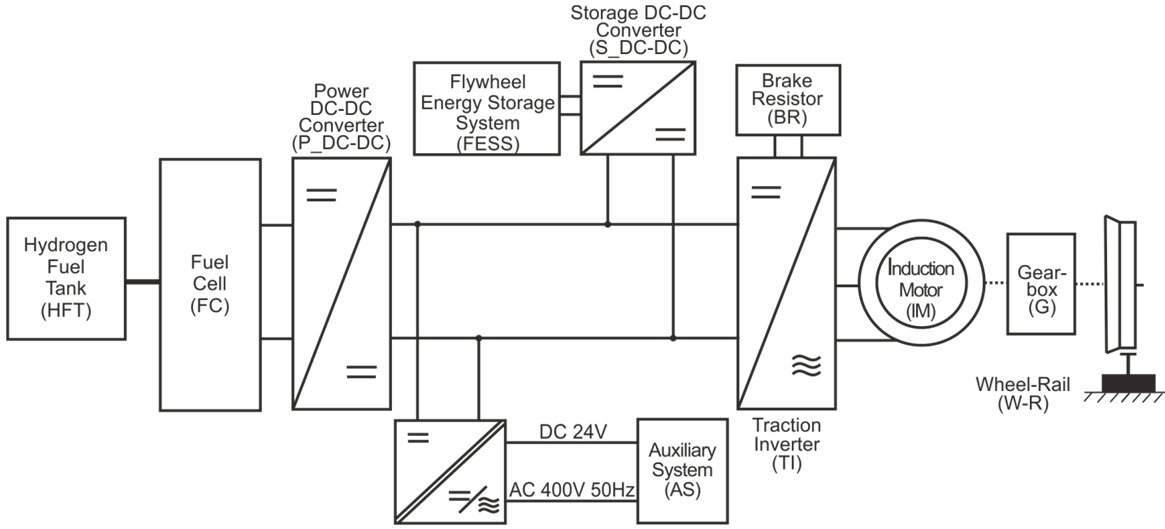Traction electric drive based on fuel cell batteries and on-board inertial energy storage for multi unit train
DOI:
https://doi.org/10.20998/2074-272X.2021.4.08Keywords:
traction electric drive, fuel cell, inertial storage, multi unit trainAbstract
The aim of the work is to study the possibility and features of the use of inertial storage devices in the traction electric drive of multi unit train with a power plant based on fuel cells. Methodology. The principle of power flow control in traction electric drives in the modes of acceleration and braking of rolling stock is proposed. The mathematical model of the traction electric drive in the form of the combination of three components: the train, the traction unit and the battery of fuel cells is developed. It was used to study the operation of a traction electric drive when solving a test traction task for rolling stock. Results. It is established that the use of inertial energy storage reduces hydrogen consumption by at least 25 %, which increases the mileage of rolling stock between equipment by more than 30 %. Originality. The traction electric drive on the basis of fuel elements and the inertial energy storage for the multi unit train is offered. The work of the proposed traction electric drive in solving the test traction problem for rolling stock is investigated. Practical significance. A mathematical model of the traction electric drive has been developed. The test traction problem for rolling stock is solved.
References
Thorne R., Amundsen A.H., Sundvor I. Battery electric and fuel cell trains: maturity of technology and market status. Report 1737/2019. Institute of Transport Economics, 2020. 32p. Available at: https://www.toi.no/getfile.php?mmfileid=52027 (accessed 22 March 2021).
Hoffrichter A., Hillmansen S., Roberts C. Conceptual propulsion system design for a hydrogen-powered regional train. IET Electrical Systems in Transportation, 2016, vol. 6, no. 2, pp. 56-66. doi: https://doi.org/10.1049/iet-est.2014.0049.
Fender K. Development of hydrogen-powered trains continues, but battery-powered equipment making more inroads. December 14, 2020. Available at: https://www.trains.com/trn/news-reviews/news-wire/development-of-hydrogen-powered-trains-continues-but-battery-powered-equipment-making-more-inroads (accessed 22 March 2021).
Furuta R., Kawasaki J., Kondo K. Hybrid traction technologies with energy storage devices for nonelectrified railway lines. IEEJ Transactions on Electrical and Electronic Engineering, 2010, vol. 5, no. 3, pp. 291-297. doi: https://doi.org/10.1002/tee.20532.
Ogawa K., Yamamoto T., Hasegawa H., Furuya T. Development of the fuel-cell/battery hybrid railway vehicle. 2009 IEEE Vehicle Power and Propulsion Conference, 2009, pp. 1730-1735. doi: https://doi.org/10.1109/vppc.2009.5289693.
Chen X., Shen W., Vo T.T., Cao Z., Kapoor A. An overview of lithium-ion batteries for electric vehicles. 2012 10th International Power & Energy Conference (IPEC), 2012, pp. 230-235. doi: https://doi.org/10.1109/asscc.2012.6523269.
Baumann M., Peters J. F., Weil M., Grunwald A. CO2 footprint and life-cycle costs of electrochemical energy storage for stationary grid applications. Energy Technology, 2017, vol. 5, no. 7, pp. 1071-1083. doi: https://doi.org/10.1002/ente.201600622.
Liu X., Li K. Energy storage devices in electrified railway systems: A review. Transportation Safety and Environment, 2020, vol. 2, no. 3, pp. 183-201. doi: https://doi.org/10.1093/tse/tdaa016.
Hedlund M., Lundin J., De Santiago J., Abrahamsson J., Bernhoff H. Flywheel energy storage for automotive applications. Energies, 2015, vol. 8, no. 10, pp. 10636-10663. doi: https://doi.org/10.3390/en81010636.
Engel B., Söffker C., Hörl F. The innovative traction system with the flywheel of the LirexTM. Available at: http://www.railway-research.org/IMG/pdf/457.pdf (accessed 22 March 2021).
Ogawa K., Yoneyama T., Sudo T., Kashiwagi T., Yamamoto T. Performance improvement of fuel cell hybrid powered test railway vehicle. Quarterly Report of RTRI, 2021, vol. 62, no. 1, pp. 16-21. doi: https://doi.org/10.2219/rtriqr.62.1_16.
Omelyanenko V.I, Riabov Ie.S., Overianova L.V. Inertial energy storage device as an advanced energy conservation technology for electric rolling stock. Vestnik VELNII, 2013, no. 1 (65), pp. 38-54. (Rus).
Omelianenko H.V., Overianova L.V., Maslii A.S. Geometric and electrophysical parameters of armature winding of electromechanical converter of inertial energy storage for suburban trains. Electrical Engineering & Electromechanics, 2020, no. 1, pp. 65-71. doi: https://doi.org/10.20998/2074-272x.2020.1.11.
Severin V.P., Omelianenko О.V. Traction drive of electric train with inertial energy storage. Bulletin of the National Technical University «KhPI». Series: Problems of Automated Electrodrivs. Theory and Practice. Power Electronics and Energy Efficiency, 2017, no. 27 (1249), pp. 276-279. Available at: http://repository.kpi.kharkov.ua/bitstream/KhPI-Press/33984/1/vestnik_KhPI_2017_27_Severin_Tyagovyy_privod.pdf (accessed 22 March 2021). (Rus).
HyPM™ HD 30 Heavy Duty Fuel Cell Power Module. Available at: https://pdf.directindustry.com/pdf/hydrogenics/hypm-hd-30/33492-420319.html (accessed 22 March 2021).
Ahluwalia R.K., Hua T.Q., Peng J.-K. Fuel cycle efficiencies of different automotive on-board hydrogen storage options. International Journal of Hydrogen Energy, 2007, vol. 32, no. 15, pp. 3592-3602. doi: https://doi.org/10.1016/j.ijhydene.2007.03.021.

Downloads
Published
How to Cite
Issue
Section
License
Copyright (c) 2021 V. I. Omelyanenko, Ie. S. Riabov, L. V. Overianova, H. V. Omelianenko

This work is licensed under a Creative Commons Attribution-NonCommercial 4.0 International License.
Authors who publish with this journal agree to the following terms:
1. Authors retain copyright and grant the journal right of first publication with the work simultaneously licensed under a Creative Commons Attribution License that allows others to share the work with an acknowledgement of the work's authorship and initial publication in this journal.
2. Authors are able to enter into separate, additional contractual arrangements for the non-exclusive distribution of the journal's published version of the work (e.g., post it to an institutional repository or publish it in a book), with an acknowledgement of its initial publication in this journal.
3. Authors are permitted and encouraged to post their work online (e.g., in institutional repositories or on their website) prior to and during the submission process, as it can lead to productive exchanges, as well as earlier and greater citation of published work.




